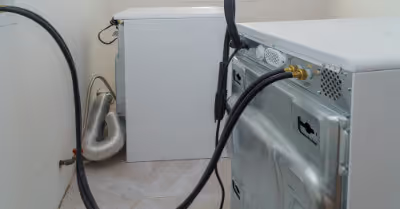Table of Contents
What Happens if Grass is Too Tall?
Sometimes grass seems to grow faster than we can, or want to, mow it. I know I can get lazy and put off mowing too long. This is especially true since I have warm-season grass so the time when my grass is growing the fastest is the same time it gets increasingly hot in the Summer. However, it is important that you do not let it grow too long.
If grass gets to 3 inches and taller, the roots and bases struggle to support the blades. This can make the blades droop and smother the grass around them. In addition, long drooping grass can trap moisture in spots, particularly lower areas, which can spread disease and fungus.
Long grass can make your entire home look unwelcoming and disorderly. It may also begin to grow unevenly which makes some parts turn yellow or even brown. Also, if you let grass grow too long and then mow it, grass shock may occur. Grass shock weakens the roots and lawn which can increase the likelihood of diseases and pests.
Another issue that may happen if you let your grass grow excessively long is that the clippings may settle between the blades of grass. The long grass clippings can smother the healthy grass. Then the heat can make the grass more likely to harbor disease. This is most likely during the warmest months of the year.
Finally, letting grass grow too long can make it difficult to mow. When I am lazy and my lawn mowing frequency decreases while the grass is still growing steadily, then it becomes much harder for me to mow it. This defeats the entire purpose of the laziness, so you may as well forget about procrastination and get it done when it needs it.
What Happens if You Cut Your Grass Too Short?
It is actually worse to cut grass too short or too often than it is to grow it too long. The blades of grass feed on sunlight using photosynthesis and won’t be able to get the adequate amount of sunlight if the grass is cut too short. This makes the grass feed on the reserve that is stored in the roots. This will decrease the supply of nutrients and weaken the roots.
When grass is cut too short, it is less likely to survive extreme conditions and drought. It also makes it easier for invasive weeds to grow. In addition, a dull mower blade will make the problems even worse. The blades should always be sliced off evenly and never appear frayed.
How Often Should Mow Lawns
Lawn mowing frequency depends greatly on the season so it is best to look at some guidelines for each of the possible growing seasons. In addition, the type of grass determines the length that it should be cut to. Instead of focusing on how often you mow, you should focus on keeping your grass at a good length.
You should try to mow off the top third of the grass blades in order to get the grass to the optimal length for the type. During heavy growing times, this is around once a week, but could be less or even more depending on the grass, climate, and other factors.
Another tip is to vary the direction that you mow the lawn. It may be tempting to use the same pathways every time, especially when it makes the process faster or easier. However, changing up the directions can help the grass grow straight up and avoid trenches dug by the lawn mower wheels.
Spring
When Spring arrives that means it is time to bring out the lawn mower (along with all sorts of other tools to keep your lawn nice and healthy). The Spring is important because the work you do can determine how healthy your lawn is for the remainder of the growing season.
It is important that you don’t get too eager to mow the lawn for the first time. Make sure that the grass is at least two inches tall before you cut it. Set your lawn mowing height to cut off the top third of the blades like you would normally do.
A lot of homeowners, myself included, like to fertilize their yard in the early Spring. If you do, make sure that the fertilizing is completely absorbed before you mow. Spring is also a good time to overseed the yard, but if you do so you never want to mow too soon because the young grass doesn’t have a strong root system.
Spring also means more rain and for some places the fastest growing time of the year. You should make sure that you mow frequently. This may mean that you have to cut the grass once every 5 days or even less for fast growing types of grass.
Summer
This is the time of year when many grass types grow rapidly and it is often more of a chore to mow due to the blistering heat. However, if you want your lawn to remain healthy, it needs to be done.
Like any other time, you should cut the top third of the blades off every time you mow and keep the after mowing height fairly consistent. However, it is important to note that you should keep the lawn a little longer during the Summer months than you had it during the Spring. Typically, this means that the grass should be around 3 inches after it has been mowed. This is only a guideline and may vary for some grass types.
Many grasses will grow a full inch in just 3 to 5 days during the Summer which means you should cut it a little more than once a week. Also, be sure to make up for the water that is being evaporated by the direct sunlight and reduced rainfall by watering more frequently.
Fall
Typically grass growth will slow drastically during the month or stop altogether in colder areas or those that receive snowfall. However, mowing might still be necessary in warmer climates. It is important to note that cooler temperatures with moisture from rain, snow, or ice can create a good environment for mold and mildew.
Sometimes there are only a few scattered warm days throughout the entire season. Do not just mow on these days because they are warm, or even hot. The lawn will be dormant. Instead, mow your grass low enough to make it through the Winter.
If you live in a very warm climate, you may still have to mow throughout the entire Autumn months. However, the mowing frequency will decrease. You may only have to mow once every two or even three weeks.
Winter
If you live in a hot climate, you may have to mow once or twice during the Winter. However, this will only be necessary for areas that almost never drop below 40 degrees Fahrenheit. Even then, many people will find that they do not have to mow at all throughout the Winter months.
Recommended Lengths for Popular Grass Types
Warm-Season Grasses
Warm-season grasses grow fastest during the Summer months. The types of grasses still have differing ideal lengths. Even under different types of grass, the subtypes may have different lengths that are ideal for growth. However, this table gives recommended guidelines.
Cool-Season Grasses
Cool-season grass grows the most rapidly during the Spring and the Fall. Typically, the ideal grass height for cool-season grass types falls between 1 and 4 inches. These are guidelines for the ideal length of different cool-season grass types.
Recent Articles
















